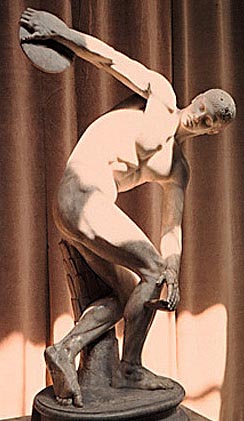lecture 5 - Greece
Bronze Age - c. 3000 B.C.
1500 B.C. - Mainland Dominance
1400 B.C. - Achaean Dominance
1200 - Doric Invasion (perhaps the foundation for
the 'Trojan War' of ancient literature)
post 1200 - spread of Greek culture to Asia Minor
Archaic Period - 8th - 5th Cent BC
Mycenaean influences ('Geometric
Period')
such as this light-hearted figure in terra-cotta
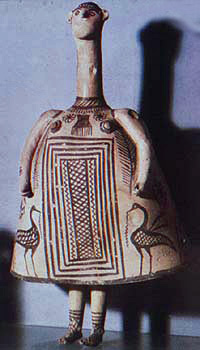
Boeotia, Greece: Idol in form of Bell
800 B.C., terra-cotta
Bell
Idol - The Louvre |
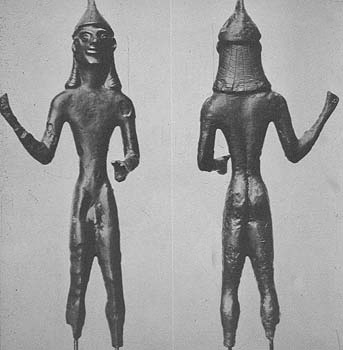
c. 8th cent. B.C. - bronze warrior sculpture
(from the Acropolis)
|
776 - 1st Olympiad

c. 610-600 B.C. - Kouros (Male) Figure
Attica region, Marble 72" Archaic |

650 B.C. - Kore (Female) Figure
These were tributes to the dead - Egyptian influence |
600 - 650 - replacement of monarchies with oligarchies
650 - 500 - wealthy commoners & tyrants overthrow aristocrats
683 - Athens - nobles abolished kingship
621 - Draco - 'Athenian Law'
|
Classical Period - 5th - 4th Century B.C.
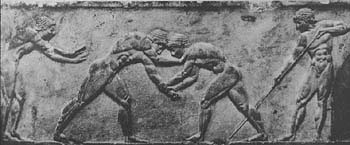
525 B.C. - Bas Relief sculpture of wrestlers (Athens)
510 - Democracy in Athens

Miletus Marble Torso, 490 B.C.
fragments are typical, since most
complete examples are Roman copies.
Miletus
Torso - The Louvre
480 - Persian Wars / Victory at Thermopylae / Athenian naval victory
decisive
478 - Delian League (dominated by Athens)
/ Pericles, Statesman of Athens- 460
High Classical Period
|
|
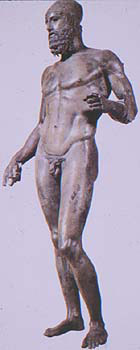
Warrior from Sea of Riace
c. 450 B.C. Bronze, 78"
Riace
Warriors - Khan Academy
This time period:
development of 'sculpture in the round'
|
Parthenon rebuilt - 448-432
Peloponnesian Wars - disunity among the city states of the peninsula
- war from 431-404
359 - Phillip II of Macedonia - by 338 his kingdom dominates Greece
Hellenistic Period
336 - Alexander the Great inherits throne -
war with Persia successful
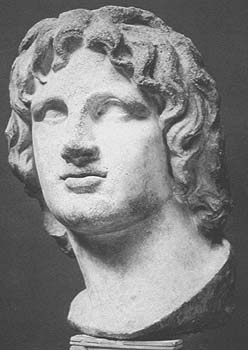
Many portraits of important people
were created posthumously,
such as this one of Alexander, c. 4th or
3rd cent. B.C.
|
By time of Alexander's death in 323,
the vast empire also included Egypt and parts of India.
Hellenistic includes 'genre' scenes & commoners, such
as this sculpture of a
Drunken or Beggar Woman, early 2nd cent
B.C.
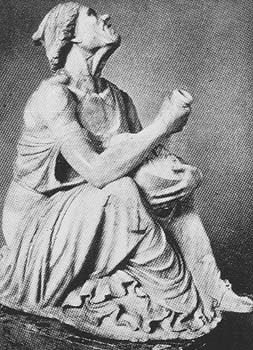
|
The Hellenistic period is generally the time of Alexander
through the time of his successors until the time of the
Roman Period, which was finalized in 146 BC.
Some consider this early Roman period Hellenistic, too,
since most of the sculptors were still Greek.
Hellenistic Sculptors:
Lysippos
- Wikipedia
'Scopas'
of Paros - Ellopos.net
Skopas
the Parian - About Paros, Greece
Praxiteles
- Ancient Greece.com
Right:
Atalante - University of Pennsylvania
"Atalanta"
- Theoi.com
|
This period also specialized
in sculptural figures in full motion:
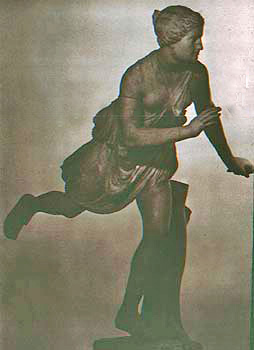
Atalante - Hellenistic Greek
|
Home | Lecture
1 | Lecture 2
| Lecture 3 | Lecture
4 | Lecture 6
